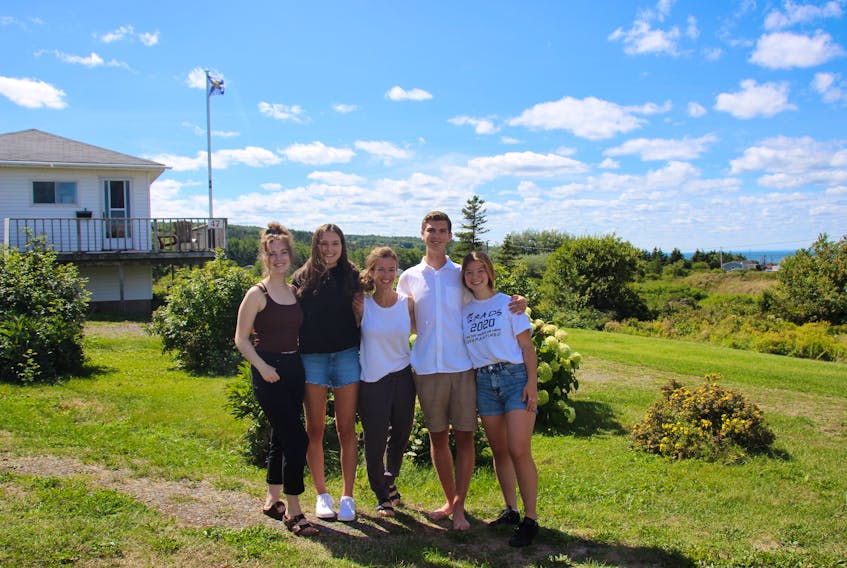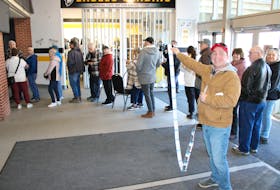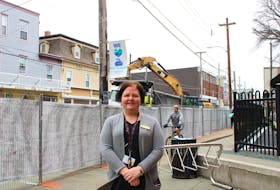ANTIGONISH, N.S. — On Aug. 22, Lynn Ross D’Albertanson landed at Halifax Stanfield International Airport with four St. Francis Xavier University students.
“I am the auntie who has the flexible schedule for long enough to do the quarantine and the moves,” said D’Albertanson.
“I am calling it COVID Camp 2020 with Auntie Lynn.”
Two of the students are her own children and two are her nieces.
They and 1,260 of the more than 4,000 students enrolled at St. F.X. this fall are from outside the Atlantic bubble.
Statistically speaking, 0.518 of the students coming to Antigonish can be expected to be carriers of COVID-19.
It would take a mathematician to say half of one student out of the 1,260 arriving is likely to be infected.
“Although one can quibble about specifics of the assumptions, we would not expect this final number (0.518) to change dramatically (i.e., an order of magnitude) under any valid update in assumptions,” reads a discussion paper by Ryan Lukeman and Rebecca Martino of the school’s Department of Mathematics and Statistics.
The pair looked at where the non-bubble students were coming from (1,048 from Ontario, 245 from Alberta, small numbers from other provinces, 43 from China, 53 from India, 56 from the United States and 27 from the Bahamas), then factored in the likelihood that a member of the 20- to 29-year-old cohort from each of those locales is an asymptomatic carrier of the virus based on local data.
Not included in their estimate is the risk potential of students catching the virus while flying to Nova Scotia.
“Using air travel increases risk of being infected with COVID-19, but data to quantify the increase in risk is not available, and depends on domestic versus international travel, number of stopovers, and so on,” explains the discussion paper.
“In this calculation, we ignore increase in risk due to the proportion of students who use air travel to arrive. Arrival by flight is certainly expected for most international students. However, international students comprise only about 5.9 per cent of our student body, and risk is lowered due to those international students that stayed in NS for the duration of the pandemic.”
The morning after their arrival, Camp COVID 2020 with Auntie Lynn got a call from Public Health. That afternoon she drove her four students to be tested at a campus gymnasium.
The vast majority of the students attending the fall semester at St. F.X. arrived last Friday. The deadline to arrive and enter self-isolation in order to be able attend classes when they start Sept. 14 was Sunday.
The return of university students has put small towns on edge.
On Monday, the province announced a positive test result for a Universite Sainte-Anne student in Church Point, along with two probable cases involving Acadia and Dalhousie University students.
All had arrived to attend classes from outside the Atlantic bubble.
Then on Tuesday it was revealed that the Universite Saint-Anne student hadn’t self-isolated prior to being tested.
So far there hasn’t been a positive test among returning St. F.X. students.
And there hasn't been community spread related to the cases identified at the other schools.
Elizabeth Yeo, St. F.X. vice president of students, wasn’t sure whether all the newly arrived students had been tested yet as of her interview on Wednesday afternoon.
Like all university students returning from outside the bubble, those at her school will receive three COVID-19 tests over the course of their two-week self-isolation.
In a normal year, Antigonish would be in the midst of the annual frosh week. Posses of brightly clad and almost unbearably enthusiastic young people would be on every other street corner soliciting change for the Shinerama charity.
The lineup at Piper’s Pub would be out the door and down College Street each evening.
Locals commuting through downtown to deal with life’s responsibilities in the mornings would, according to their own individual temperament, either shake their heads at the wreckage from the previous night’s festivities or smile wistfully.
This year is so different.
It’s quiet.
Each day, a parade of masked students gets walked out of the dorms like prisoners at the North Nova Correctional Facility to get some supervised sunlight in the sports fields.
Masks are mandatory both indoors and outdoors on campus.
Some 260 community volunteers run errands and make check-ins on the off-campus students who are self-isolating.
Yeo knows that they are being watched closely by a nervous community.
“At no point would we have reopened if we didn’t have the support and approval of Public Health,” said Yeo.
“We’ve been working for months to put in place all the procedures and modifications.”
They have also been repeating the importance of following public health guidelines to students. Violation of those guidelines was made a major offense under the student code of conduct at the same meeting where the school’s Board of Governors gave the green light for a return to in-person classes.
So far, one disciplinary investigation has been begun against the same student fined $1,000 by the RCMP for not self-isolating.
If we get past this first hurdle of arriving students without community spread, the anticipated second wave still looms.
What that means for towns like Antigonish, Acadia's Wolfville, and Church Point, which have seen their populations doubled by an age cohort statistically more prone to spread the virus due to social behavior, remains to be seen.









